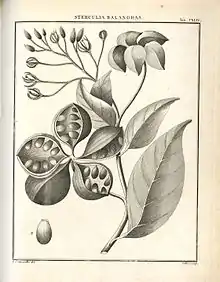Antonio José Cavanilles | |
|---|---|
 Statue of Cavanilles at the Royal Botanical Garden of Madrid | |
| Born | 16 January 1745 Valencia, Spain |
| Died | 5 May 1804 (aged 59) Madrid, Spain |
| Known for | Taxonomy of Iberian, South American and Oceanian flora |
| Scientific career | |
| Fields | Botany |
| Academic advisors | Thouin, Jussieu |
| Author abbrev. (botany) | Cav. |

Antonio José Cavanilles (16 January 1745 – 5 May 1804) was a leading Spanish taxonomic botanist of the 18th century. He named many plants, particularly from Oceania. He named at least 100 genera, about 54 of which were still used in 2004, including Dahlia, Calycera, Cobaea, Galphimia, and Oleandra.[1] The standard author abbreviation Cav. is used to indicate this person as the author when citing a botanical name.[2]
Biography
Cavanilles was born in Valencia. He lived in Paris from 1777 to 1781, where he followed careers as a clergyman and a botanist, thanks to André Thouin and Antoine Laurent de Jussieu. He was one of the first Spanish scientists to use the classification method invented by Carl Linnaeus.
From Paris he moved to Madrid, where he was director of the Royal Botanical Garden and Professor of botany from 1801 to 1804.
In 1804, Cavanilles was elected a member of the American Philosophical Society in Philadelphia.[3]
He died in Madrid in 1804.
Selected publications
See also
References
- ↑ Emilio LAGUNA LUMBRERAS (December 2004), "Sobre los géneros descritos por Cavanilles", Flora Montiberica, 28: 3–22
- ↑ International Plant Names Index. Cav.
- ↑ "APS Member History". search.amphilsoc.org. Retrieved 2021-04-01.
Further reading
- "Cavanilles, Antonio José (Joseph) (1745-1804". JSTOR Global Plants. ITHAKA. 2013.
External links
- Biography by the Australian National Botanic Gardens
- Malpighiaceae/Cavanilles
- Monadelphiæ classis dissertationes decem on the Internet Archive
- Chronophobia Scans of 160 plates from Monadelphiæ classis dissertationes decem
- Antonio José Cavanilles. Polymath Virtual Library, Fundación Ignacio Larramendi